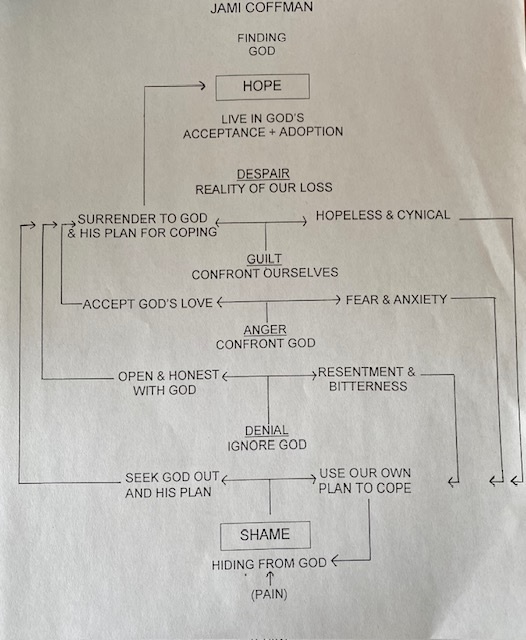Learn from yesterday, live for today, hope for tomorrow. The important thing is not to stop questioning.
– Albert Einstein
In the quote above, Albert Einstein says, “…hope for tomorrow.” What are you hoping for? Hope speaks to the deepest part of who we are. It is what keeps us going. As a child, we hope for simple things, such as hoping mom will buy us a piece of candy after getting through the grocery shopping. When we become adults, our hopes grow more complex. We have hopes for our careers, for our families, and our dreams.
Einstein encourages us to “not stop questioning.” In my last article, I shared a diagram that pictures how to move from pain to hope. Part of this process includes asking ourselves questions so that we learn and then live more fully. In the previous article, I explained the components of pain, denial, and anger. You can go to my blog post to review that article. In this article, we will cover the rest of the components.
Here is the diagram:

Guilt
When we are faced with pain, part of the process can include feeling guilty. Sometimes, we need to confront ourselves. Maybe we made a mistake that led to a consequence of pain. The pain, which is showing up in guilt, may be trying to get our attention to clean up our mess.
However, if we choose to hide from the conviction we are feeling, we can get trapped in a cycle of fear and anxiety. Sometimes, we may have done something that we need to apologize for. This will require vulnerability to apologize to another person and work to make things right or better in the relationship.
There can also be times when we feel false guilt. I see this often on assessments that I do with leaders. Some people can be overly critical of themselves. They may overanalyze or berate themselves for a mistake. This is where self-forgiveness and self-compassion also need to be practiced.
In the diagram I have it listed as “accepting God’s love.” This refers to a deeper level of accepting your value and self-worth as an individual. It is practicing self-compassion. Picture how you show empathy and compassion to a friend who has gone through a loss. Now apply that same compassion towards yourself. At a deeper level, it can be connected to a spiritual belief that there is no one else on the earth like you. You are a loved and unique creation with purpose.
Despair
Despair occurs when we face the reality of our loss. Denial, anger, and guilt can be emotions that indicate a deeper struggle within us to fight the pain and the loss that the pain may hold. And it is okay to struggle. Don’t see the struggle as bad but instead as a part of the grieving and processing. The important part of the struggle is to be aware so you struggle well.
Not struggling well is choosing to hide. We fall into rumination that closes us up into our circular thoughts. This can create habitual mindsets like scarcity, victimhood, and blame. We can even develop learned hopelessness where we give up. It is a thinking pattern that is not willing to try anymore. We can become hopeless and cynical, which isolates us and pushes others away.
When we accept the reality of our loss, we can be open to surrendering outcomes. This is still a hope for a vision of something better, but we are willing to let go of how we get there. For example, an organization will have a vision and mission. You may have a future objective for your team. An individual can have a dream. It is called a picture of success. But instead of being willful of your way to get there, you choose to become willing in how to get there.
The path may not always go the way you think. You may not reach the outcome you wanted. There will be failures, mistakes, and pain. This is where you choose to surrender the outcome and embrace how you can learn and find a new possibility through it. In my diagram I have “surrendering to God and His plan for coping.” This refers to the deeper revelation of trusting a bigger plan.
I can look back on my life and see where some things may not have happened that I thought were a loss of success and now see that what I have today is better. It is like how sometimes a mistake on a work project can lead to innovation if we take time not to hide it but embrace it, be vulnerable, and learn from it and with others.
Hope
Even in pain and the process of grief, if we choose the path of vulnerability rather than hiding, we can move forward in hope. On the diagram, I have “live in God’s acceptance and adoption.” This refers to our authenticity. It is a rest and a place of acceptance of who we are and, from a spiritual perspective, of who you are in God. The pain can move us to a new level of growth and purpose.
In my first article, I referred to how this diagram came out of my processing of the painful situation of my dad having open heart surgery. That was 24 years ago, and my dad is still alive today. However, I have found this diagram to remain a point of reflection throughout the other seasons of my life. Some of those seasons have not turned out how I thought and have ended in loss. Yet, by being real with the loss and processing through, it eventually brings me to a point of something greater, even in the surrender. I hope that it can serve as a guide for you, too.
Reflection
This can be a lot to reflect on. What insights have you gained about guilt, despair, and hope? What choices have you been making? Have the choices been cycling you back to shame and putting you in a pattern of pain? Or are you making choices that are cycling you upward toward a place of hope in growth for yourself and others?
